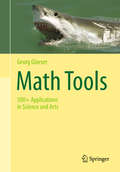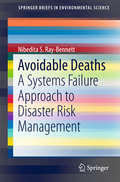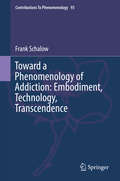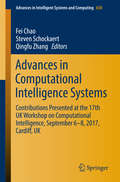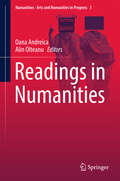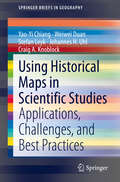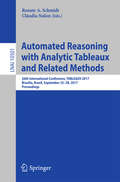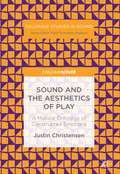- Table View
- List View
Applied Computer Sciences in Engineering: 4th Workshop on Engineering Applications, WEA 2017, Cartagena, Colombia, September 27-29, 2017, Proceedings (Communications in Computer and Information Science #742)
by Juan Carlos Figueroa-García Eduyn Ramiro López-Santana José Luis Villa-Ramírez Roberto Ferro-EscobarThis book constitutes the refereed proceedings of the Forth Workshop onEngineering Applications, WEA 2017, held in Cartagena, Colombia, inSeptember 2017. The 59 revised full papers presented were carefully reviewed and selectedfrom156 submissions. The papers are organized in topical sections such as computerscience; computational intelligence; simulation systems; internet of things; fuzzy sets and systems; power systems; logistics and operations management; miscellaneous applications.
Math Tools: 500+ Applications in Science and Arts
by Georg GlaeserIn this book, topics such as algebra, trigonometry, calculus and statistics are brought to life through over 500 applications ranging from biology, physics and chemistry to astronomy, geography and music.With over 600 illustrations emphasizing the beauty of mathematics, Math Tools complements more theoretical textbooks on the market, bringing the subject closer to the reader and providing a useful reference to students. By highlighting the ubiquity of mathematics in practical fields, the book will appeal not only to students and teachers, but to anyone with a keen interest in mathematics and its applications.
Human Duties and the Limits of Human Rights Discourse (Studies in Global Justice #17)
by Eric R. BootThis book demonstrates the importance of a duty-based approach to morality. The dominance of what has been labeled “rights talk” leads to the neglect of duties without corresponding rights (e.g., duties of virtue) and stimulates the proliferation of questionable human rights. Therefore, this book argues for a duty-based perspective on morality in order to, first, salvage duties of virtue, and, second, counter the trend of rights-proliferation by providing some conceptual clarity concerning rights and duties that will enable us to differentiate between genuine and spurious rights-claims. The argument for this duty-based perspective is made by examining two particularly contentious duties: duties to aid the global poor and civic duties. These two duties serve as case studies and are explored from the perspectives of political theory, jurisprudence and moral philosophy. The argument is made that both these duties can only be adequately defined and allocated if we adopt the perspective of duties, as the predominant perspective of rights either does not recognize them to be duties at all or else leaves their content and allocation indefinite. This renewed focus on duties does not wish to diminish the importance of rights. Rather, the duty-based perspective on morality will strengthen human rights discourse by distinguishing more strictly between genuine and inauthentic rights. Furthermore, a duty-based approach enriches our moral landscape by recognizing both duties of justice and duties of virtue. The latter duties are not less important or supererogatory, but function as indispensable complements to the duties prescribed by justice. In this perceptive and exceptionally lucid book, Eric Boot argues that a duty-focused approach to morality will remedy the shortcomings he finds in the standard accounts of human rights. The study tackles staple philosophical topics such as the contrasts between duties of virtue and duties of justice and imperfect and perfect obligations. But more importantly perhaps, it also confronts the practical question of what our human rights duties are and how we ought to act on them. Boot's book is a splendid example of how philosophy can engage and clarify real world problems.Kok-Chor Tan, Department of Philosophy, University of Pennsylvania A lively and enjoyable defence of the importance of our having duties to fellow human beings in severe poverty. At a time when global justice has never been more urgent, this new book sheds much needed light.Thom Brooks, Professor of Law and Government and Head of Durham Law School, Durham University
Psychology of Career Adaptability, Employability and Resilience
by Kobus MareeThis book examines how the career counselling profession should respond to the changes in the world of work that have resulted from the increasing need to communicate faster and disseminate information more efficiently. It emphasizes the twin aims of enhancing a persons’ career adaptability and helping them to become more employable, rather than linearly trying to find a job and remaining in one organisation for their entire career-lives. The book shows that, to achieve these aims, people need to acquire career resilience, especially since the world of work no longer provides workers with work-holding environments for the duration of their career-lives. It takes into account historical analyses which show that whenever major technological change has occurred and widespread job losses have ensued, people have managed to use the new technology to create new employment opportunities. Readers from career psychology and management research, vocational and professional career coaching, and students of career psychology will find this book delivers sound, updated theory demonstrating how perceived threats in the 21st century can conceivably be turned into opportunities.
Avoidable Deaths: A Systems Failure Approach to Disaster Risk Management (SpringerBriefs in Environmental Science)
by Nibedita S. Ray-BennettThis book addresses one of the most fundamental questions of the 21st century: why deaths continue to occur in natural disasters despite the tremendous advancements in disaster management science and weather forecasting systems, increased sophistication of human-built environments and ongoing economic and policy development worldwide. By presenting an interdisciplinary tool for analysing ‘systems failure’, the book provides concrete suggestions on how deaths may be reduced in resource-poor contexts. It goes beyond traditional risk and vulnerability perspectives and demonstrates that deaths in disasters are complex problems that can be solved by adopting a socio-technical perspective to improve current disaster management systems in the developing world. The book is a timely contribution, as it directly addresses Global Target One of the UN’s ‘Sendai Framework for Disaster Risk Reduction’, which has urged 185 UN Member States to reduce disaster mortality by 2030. Further, it offers a valuable resource for students, researchers, policy-makers and practitioners interested in disaster risk reduction, human rights, gender, sociology of risk, crisis and disasters, environmental science, organisation and management studies.
Simulating Social Complexity: A Handbook (Understanding Complex Systems)
by Bruce Edmonds Ruth MeyerThis volume examines all aspects of using agent or individual-based simulation. This approach represents systems as individual elements having their own set of differing states and internal processes. The interactions between elements in the simulation represent interactions in the target systems. What makes this "social" is that it can represent an observed society.Social systems include all those systems where the components have individual agency but also interact with each other. This includes human societies and groups, but also increasingly socio-technical systems where the internet-based devices form the substrate for interaction. These systems are central to our lives, but are among the most complex known. This poses particular problems for those who wish to understand them. The complexity often makes analytic approaches infeasible but, on the other hand, natural language approaches are also inadequate for relating intricate cause and effect. This is why individual and agent-based computational approaches hold out the possibility of new and deeper understanding of such systems.This handbook marks the maturation of this new field. It brings together summaries of the best thinking and practices in this area from leading researchers in the field and constitutes a reference point for standards against which future methodological advances can be judged.This second edition adds new chapters on different modelling purposes and applying software engineering methods to simulation development. Revised existing content will keep the book up-to-date with recent developments. This volume will help those new to the field avoid "reinventing the wheel" each time, and give them a solid and wide grounding in the essential issues. It will also help those already in the field by providing accessible overviews of current thought. The material is divided into four sections: Introduction, Methodology, Mechanisms, and Applications. Each chapter starts with a very brief section called ‘Why read this chapter?’ followed by an abstract, which summarizes the content of the chapter. Each chapter also ends with a section on ‘Further Reading’.Whilst sometimes covering technical aspects, this second edition of Simulating Social Complexity is designed to be accessible to a wide range of researchers, including both those from the social sciences as well as those with a more formal background. It will be of use as a standard reference text in the field and also be suitable for graduate level courses.
Digital Transformation in Financial Services
by Claudio ScardoviThis book analyzes the set of forces driving the global financial system toward a period of radical transformation and explores the transformational challenges that lie ahead for global and regional or local banks and other financial intermediaries. It is explained how these challenges derive from the newly emerging post-crisis structure of the market and from shadow and digital players across all banking operations. Detailed attention is focused on the impacts of digitalization on the main functions of the financial system, and particularly the banking sector. The author elaborates how an alternative model of banking will enable banks to predict, understand, navigate, and change the external ecosystem in which they compete. The five critical components of this model are data and information mastering; effective use of applied analytics; interconnectivity and “junction playing”; development of new business solutions; and trust and credibility assurance. The analysis is supported by a number of informative case studies. The book will be of interest especially to top and middle managers and employees of banks and financial institutions but also to FinTech players and their advisers and others.
Toward a Phenomenology of Addiction: Embodiment, Technology, Transcendence (Contributions To Phenomenology #93)
by Frank SchalowThis book addresses an epidemic that has developed on a global scale, and, which under the heading of “addiction,” presents a new narrative about the travails of the human predicament. The book introduces phenomenological motifs, such as desire, embodiment, and temporality, to uncover the existential roots of addiction, and develops Martin Heidegger’s insights into technology to uncover the challenge of becoming a self within the impulsiveness and depersonalization of our digital age. By charting a new path of philosophical inquiry, the book allows a pervasive, cultural phenomenon, ordinarily reserved to psychology, to speak as a referendum about the danger which technology poses to us on a daily basis. In this regard, addiction ceases to be merely a clinical malady, and instead becomes a “signpost” to exposing a hidden danger posed by the assimilation of our culture within a technological framework.
Advances in Computational Intelligence Systems: Contributions Presented at the 17th UK Workshop on Computational Intelligence, September 6-8, 2017, Cardiff, UK (Advances in Intelligent Systems and Computing #650)
by Fei Chao Steven Schockaert Qingfu ZhangThe book is a timely report on advanced methods and applications of computational intelligence systems. It covers a long list of interconnected research areas, such as fuzzy systems, neural networks, evolutionary computation, evolving systems and machine learning. The individual chapters are based on peer-reviewed contributions presented at the 17th Annual UK Workshop on Computational Intelligence, held on September 6-8, 2017, in Cardiff, UK. The book puts a special emphasis on novels methods and reports on their use in a wide range of applications areas, thus providing both academics and professionals with a comprehensive and timely overview of new trends in computational intelligence.
Intelligent Computations: Abstract Fractional Calculus, Inequalities, Approximations (Studies in Computational Intelligence #734)
by George A. AnastassiouThis brief book presents the strong fractional analysis of Banach space valued functions of a real domain. The book’s results are abstract in nature: analytic inequalities, Korovkin approximation of functions and neural network approximation. The chapters are self-contained and can be read independently.This concise book is suitable for use in related graduate classes and many research projects. An extensive list of references is provided for each chapter. The book’s results are relevant for many areas of pure and applied mathematics. As such, it offers a unique resource for researchers, and a valuable addition to all science and engineering libraries.
Thermoacoustics: A Unifying Perspective for Some Engines and Refrigerators
by Gregory W. SwiftThis updated new edition provides an introduction to the field of thermoacoustics. All of the key aspects of the topic are introduced, with the goal of helping the reader to acquire both an intuitive understanding and the ability to design hardware, build it, and assess its performance. Weaving together intuition, mathematics, and experimental results, this text equips readers with the tools to bridge the fields of thermodynamics and acoustics. At the same time, it remains firmly grounded in experimental results, basing its discussions on the distillation of a body of experiments spanning several decades and countries. The book begins with detailed treatment of the fundamental physical laws that underlie thermoacoustics. It then goes on to discuss key concepts, including simple oscillations, waves, power, and efficiency. The remaining portions of the book delve into more advanced topics and address practical concerns in applications chapters on hardware and measurements. With its careful progression and end-of-chapter exercises, this book will appeal to graduate students in physics and engineering as well as researchers and practitioners in either acoustics or thermodynamics looking to explore the possibilities of thermoacoustics. This revised and expanded second edition has been updated with an eye to modern technology, including computer animations and DeltaEC examples.
Motivating Language Theory
by Jacqueline Mayfield Milton MayfieldThis book presents the findings, applications, and theoretical underpinnings of a unique leadership communication model: motivating language theory. Drawing from management, social science, and communication theories, motivating language theory demonstrates how leader-to-follower speech improves employee and organizational well-being and drives positive workplace outcomes (such as employee performance, retention, and job satisfaction) in a wide array of settings. It presents an integrated model based on empirical findings and theoretical developments from the past three decades to explore the three dimensions of motivating language: direction giving language, empathetic language, and meaning-making language. It will be a comprehensive source for its empirical relationships, generalizability, theoretical basis, and future directions for research and practice.
Advances in Production Management Systems. The Path to Intelligent, Collaborative and Sustainable Manufacturing: IFIP WG 5.7 International Conference, APMS 2017, Hamburg, Germany, September 3-7, 2017, Proceedings, Part II (IFIP Advances in Information and Communication Technology #514)
by Hermann Lödding Ralph Riedel Klaus-Dieter Thoben Gregor Von Cieminski Dimitris KiritsisThe two-volume set IFIP AICT 513 and 514 constitutes the refereed proceedings of the International IFIP WG 5.7 Conference on Advances in Production Management Systems, APMS 2017, held in Hamburg, Germany, in September 2017.The 121 revised full papers presented were carefully reviewed and selected from 163 submissions. They are organized in the following topical sections: smart manufacturing system characterization; product and asset life cycle management in smart factories of industry 4.0; cyber-physical (IIoT) technology deployments in smart manufacturing systems; multi-disciplinary collaboration in the development of smart product-service solutions; sustainable human integration in cyber-physical systems: the operator 4.0; intelligent diagnostics and maintenance solutions; operations planning, scheduling and control; supply chain design; production management in food supply chains; factory planning; industrial and other services; operations management in engineer-to-order manufacturing; gamification of complex systems design development; lean and green manufacturing; and eco-efficiency in manufacturing operations.
Advances in Production Management Systems. The Path to Intelligent, Collaborative and Sustainable Manufacturing: IFIP WG 5.7 International Conference, APMS 2017, Hamburg, Germany, September 3-7, 2017, Proceedings, Part I (IFIP Advances in Information and Communication Technology #513)
by Hermann Lödding Ralph Riedel Klaus-Dieter Thoben Gregor Von Cieminski Dimitris KiritsisThe two-volume set IFIP AICT 513 and 514 constitutes the refereed proceedings of the International IFIP WG 5.7 Conference on Advances in Production Management Systems, APMS 2017, held in Hamburg, Germany, in September 2017.The 121 revised full papers presented were carefully reviewed and selected from 163 submissions. They are organized in the following topical sections: smart manufacturing system characterization; product and asset life cycle management in smart factories of industry 4.0; cyber-physical (IIoT) technology deployments in smart manufacturing systems; multi-disciplinary collaboration in the development of smart product-service solutions; sustainable human integration in cyber-physical systems: the operator 4.0; intelligent diagnostics and maintenance solutions; operations planning, scheduling and control; supply chain design; production management in food supply chains; factory planning; industrial and other services; operations management in engineer-to-order manufacturing; gamification of complex systems design development; lean and green manufacturing; and eco-efficiency in manufacturing operations.
Overconfidence in SMEs: Conceptualisations, Domains and Applications
by Anna InvernizziThis book presents a review of the role of overconfidence in small firms and explores how biased judgment and decision-making can affect business performance. Whilst the overconfidence construct has been studied in detail, there are no systematic reviews of its role in SMEs as of yet. Examining the decisions made by entrepreneurs, this study offers clear solutions on how to improve business accuracy, reduce disadvantageous investments and prevent bankruptcy. Providing an empirical analysis of overconfidence in the sport industry, this new book will not only be of interest to academics of entrepreneurship and small enterprises, but also to sport managers.
Advances in Databases and Information Systems: 21st European Conference, ADBIS 2017, Nicosia, Cyprus, September 24-27, 2017, Proceedings (Lecture Notes in Computer Science #10509)
by Mārīte Kirikova, Kjetil Nørvåg and George A. PapadopoulosThis book constitutes the proceedings of the 21st European Conference on Advances in Databases and Information Systems, ADBIS 2017, held in Nicosia, Cyprus, in September 2017.The 26 regular papers presented together with one keynote paper and one keynote abstract were carefully selected and reviewed from numerous submissions. The papers are organized in topical sections such as conceptual modeling and human factors; subsequence matching and streaming data; OLAP; graph databases; spatial data management; parallel and distributed data processing; query optimization, recovery, and databases on modern hardware; semantic data processing; and additional database and information systems topics.
Readings in Numanities (Numanities - Arts and Humanities in Progress #3)
by Oana Andreica Alin OlteanuThis unique book gathers articles from the numanistic perspective of multidisciplinarity and innovation, connected by three main theoretical interests or overarching themes: music, semiotics and translation. Offering an eclectic collection of innovative papers that address such topics as culture, musicology, art consumption, meaning, codes and national identities, to name a few, it has a broad appeal across the humanities and social sciences. The contributing authors draw on various schools and methodologies, including psychology, psychoanalysis, social semiotics, semiotic modelling, deconstruction and cultural analysis. By approaching established themes in new and challenging ways, this highly engaging book has the potential to advance the state of the art in various topics. It appeals to all scholars investigating cultural identity, linguistics and translation, music consumption, performance, semiotic theories and various intersections of these and related topics.
The Changing Faces of Space (Studies in Applied Philosophy, Epistemology and Rational Ethics #39)
by Maria Teresa Catena Felice MasiThis book focuses on various concepts of space and their historical evolution. In particular, it examines the variations that have modified the notions of place, orientation, distance, vacuum, limit, bound and boundary, form and figure, continuity and contingence, in order to show how spatial characteristics are decisive in a range of contexts: in the determination and comprehension of exteriority; in individuation and identification; in defining the meaning of nature and of the natural sciences; in aesthetical formations and representations; in determining the relationship between experience, behavior and environment; and in the construction of mental and social subjectivity. Accordingly, the book offers a comprehensive review of concepts of space as formulated by Kant, Husserl, Heidegger, Einstein, Heisenberg, Penrose and Thorne, subsequently comparing them to notions developed more recently, in the current age, which Foucault dubbed the age of space. The book is divided into four distinct yet deeply interconnected parts, which explore the space of life, the space of experience, the space of science and the space of the arts.
Using Historical Maps in Scientific Studies: Applications, Challenges, and Best Practices (SpringerBriefs in Geography)
by Yao-Yi Chiang Weiwei Duan Stefan Leyk Johannes H. Uhl Craig A. KnoblockThis book illustrates the first connection between the map user community and the developers of digital map processing technologies by providing several applications, challenges, and best practices in working with historical maps. After the introduction chapter, in this book, Chapter 2 presents a variety of existing applications of historical maps to demonstrate varying needs for processing historical maps in scientific studies (e.g., thousands of historical maps from a map series vs. a few historical maps from various publishers and with different cartographic styles). Chapter 2 also describes case studies introducing typical types of semi-automatic and automatic digital map processing technologies. The case studies showcase the strengths and weaknesses of semi-automatic and automatic approaches by testing them in a symbol recognition task on the same scanned map. Chapter 3 presents the technical challenges and trends in building a map processing, modeling, linking, and publishing framework. The framework will enable querying historical map collections as a unified and structured spatiotemporal source in which individual geographic phenomena (extracted from maps) are modeled (described) with semantic descriptions and linked to other data sources (e.g., DBpedia, a structured version of Wikipedia). Chapter 4 dives into the recent advancement in deep learning technologies and their applications on digital map processing. The chapter reviews existing deep learning models for their capabilities on geographic feature extraction from historical maps and compares different types of training strategies. A comprehensive experiment is described to compare different models and their performance.Historical maps are fascinating to look at and contain valuable retrospective place information difficult to find elsewhere. However, the full potential of historical maps has not been realized because the users of scanned historical maps and the developers of digital map processing technologies are from a wide range of disciplines and often work in silos. Each chapter in this book can be read individually, but the order of chapters in this book helps the reader to first understand the “product requirements” of a successful digital map processing system, then review the existing challenges and technologies, and finally follow the more recent trend of deep learning applications for processing historical maps. The primary audience for this book includes scientists and researchers whose work requires long-term historical geographic data as well as librarians. The secondary audience includes anyone who loves maps!
Recent Developments and Achievements in Biocybernetics and Biomedical Engineering: Proceedings of the 20th Polish Conference on Biocybernetics and Biomedical Engineering, Kraków, Poland, September 20-22, 2017 (Advances in Intelligent Systems and Computing #647)
by Piotr Augustyniak Roman Maniewski Ryszard TadeusiewiczThis book presents the best 27 papers from the 20th Polish Conference on Biocybernetics and Biomedical Engineering (PCBBE) hosted by the AGH University of Science and Technology in Krakow. This biannual event has been held for nearly four decades and offers scientists and professionals from the fields of engineering, medicine, physics, and computer science an excellent platform for exchanging ideas. Biocybernetics and biomedical engineering is currently considered a promising approach to improving healthcare – and consequently quality of life. Innovative technical solutions not only respond to the needs of caregivers, but also stimulate the development of medical sciences by supporting medical practitioners, and we are currently witnessing a profound change of the role of medicine that has become ubiquitous in everyday life thanks to recent technological advances. The development of civilization manifests itself in a growing focus on investigating the secrets of the human life, continuous efforts to support life, and mimicking biological systems in engineering. Presenting the latest developments in all areas of biomedical engineering, the book is a valuable resource for researchers and scientists in the field.
Automated Reasoning with Analytic Tableaux and Related Methods: 26th International Conference, TABLEAUX 2017, Brasília, Brazil, September 25–28, 2017, Proceedings (Lecture Notes in Computer Science #10501)
by Renate A. Schmidt Cláudia NalonThis book contains the proceedings of the 26th International Conference on Automated Reasoning with Analytics Tableaux and Related Methods, TABLEAUX 2017, held in Brasília, Bazil, in September 2017. The 19 contributed papers presented in this volume were carefully reviewed and selected from 27 submissions.They are organized in topical sections named: Sequent systems; tableaux; transitive closure and cyclic proofs; formalization and complexity. Also included are papers of three invited speakers.
Sound and the Aesthetics of Play: A Musical Ontology of Constructed Emotions (PDF)
by Justin ChristensenThis book is an interdisciplinary project that brings together ideas from aesthetics, philosophy, psychology, and music sociology as an expansion of German philosopher Hans-Georg Gadamer’s theory on the aesthetics of play. This way of thinking focuses on an ontology of the process of musicking rather than an ontology of discovering fixed and static musical objects. In line with this idea, the author discusses the importance of participation and involvement in this process of musicking, whether as a listener or as a performer. Christensen then goes on to critique and update Gadamer's theory by presenting incompatibilities between it and recent theories of aesthetic emotions and embodiment. He proposes that emotions are ‘constructed’ rather than ‘caused’, that the mind uses a system of ‘filters’ to respond to sonic stimuli and thus constructs (via play) aesthetic feelings and experiences. In turn, this approach provides music with a route into the development of social capital and inter-subjective communication. This work builds on the hermeneutical steps already taken by Gadamer and those before him, continuing his line of thought beyond his work. It will be of great interest to scholars in music aesthetics as well as a variety of other music related fields, including music psychology, philosophy and science and technology studies.
Sound and the Aesthetics of Play
by Justin ChristensenThis book is an interdisciplinary project that brings together ideas from aesthetics, philosophy, psychology, and music sociology as an expansion of German philosopher Hans-Georg Gadamer's theory on the aesthetics of play. This way of thinking focuses on an ontology of the process of musicking rather than an ontology of discovering fixed and static musical objects. In line with this idea, the author discusses the importance of participation and involvement in this process of musicking, whether as a listener or as a performer. Christensen then goes on to critique and update Gadamer's theory by presenting incompatibilities between it and recent theories of aesthetic emotions and embodiment. He proposes that emotions are 'constructed' rather than 'caused', that the mind uses a system of 'filters' to respond to sonic stimuli and thus constructs (via play) aesthetic feelings and experiences. In turn, this approach provides music with a route into the development of social capital and inter-subjective communication. This work builds on the hermeneutical steps already taken by Gadamer and those before him, continuing his line of thought beyond his work. It will be of great interest to scholars in music aesthetics as well as a variety of other music related fields, including music psychology, philosophy and science and technology studies.
Sustained Simulation Performance 2017: Proceedings of the Joint Workshop on Sustained Simulation Performance, University of Stuttgart (HLRS) and Tohoku University, 2017
by Michael M. Resch Wolfgang Bez Erich Focht Michael Gienger Hiroaki KobayashiThis book presents the state of the art in High Performance Computing on modern supercomputer architectures. It addresses trends in hardware and software development in general, as well as the future of High Performance Computing systems and heterogeneous architectures. The contributions cover a broad range of topics, from improved system management to Computational Fluid Dynamics, High Performance Data Analytics, and novel mathematical approaches for large-scale systems. In addition, they explore innovative fields like coupled multi-physics and multi-scale simulations. All contributions are based on selected papers presented at the 24th Workshop on Sustained Simulation Performance, held at the University of Stuttgart’s High Performance Computing Center in Stuttgart, Germany in December 2016 and the subsequent Workshop on Sustained Simulation Performance, held at the Cyberscience Center, Tohoku University, Japan in March 2017.

